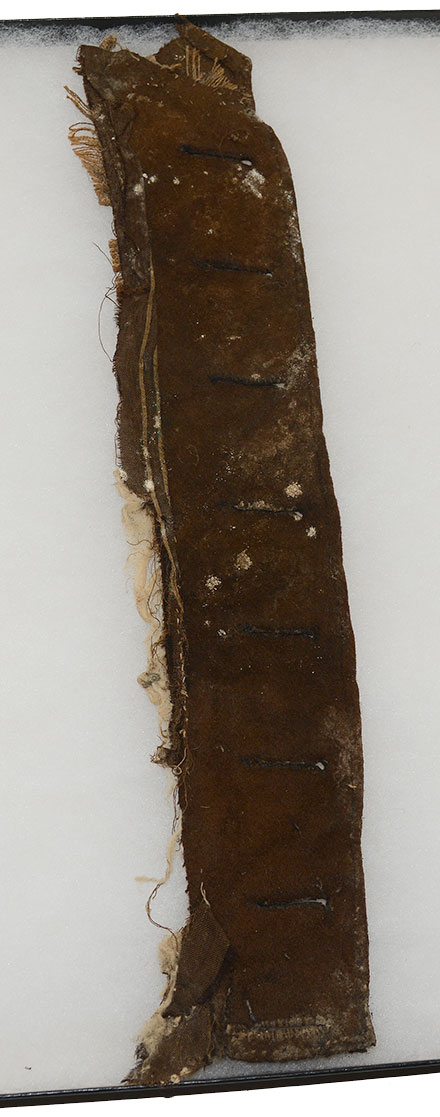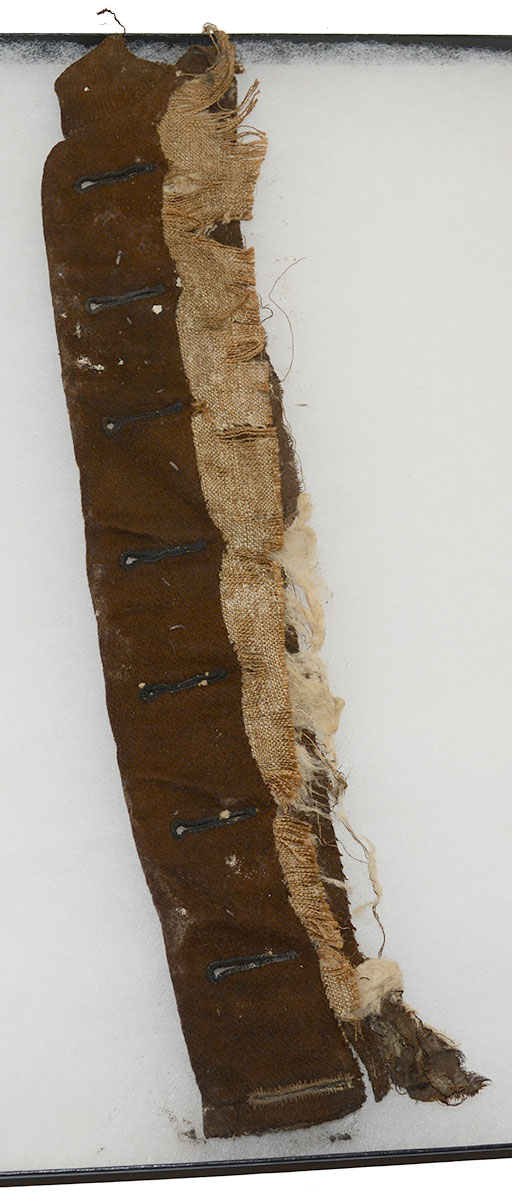site search
online catalog
US ARMY DRESS COAT LAPEL FROM FORT PEMBINA, ND

Hover to zoom


$250.00
Quantity Available: 1
Item Code: 1052-589
Shipping: Determined by Method & Location of buyer
To Order:
Call 717-334-0347,
Fax 717-334-5016, or E-mail
This coat lapel comes from the left side of US army dress coat discarded by a soldier at Fort Pembina, ND, and was excavated in wet, anaerobic soil that has preserved leather and cloth in remarkable condition. This small frontier army post was in operation from 1870 to 1895 and material excavated there shows the typical postwar army mix of Civil War issue material being used well into the 1870s, along with later army experimental, issue, and private purchase patterns, with some of the more regulation material also shown in the few extant photographs made of troops at the post. Eight buttonholes are preserved, indicating it came from a regulation dress coat rather than a fatigue blouse. The fabric is soft, pliable, and displays well, showing some of the interlining and coat lining, with the color of the coat fabric just shifting from blue to a light brown and olive.
The excavations at the fort were conducted on private property with the owner’s permission. Situated in the Red River Valley in North Dakota near the Canadian border, the Fort Pembina was established in 1870 and in operation until 1895. Trading posts existed earlier in the area as part of the fur trade, and the first U.S. military post there was temporary- manned by a detachment of Minnesota troops in 1863-1864 following the 1862 Sioux uprising. In March 1870 a new fort was established south of the Pembina River and about 200 yards west of the Red River, completed by July and named in honor of Gen. George H. Thomas. The name was changed to Fort Pembina in September and the initial garrison consisted of two companies of the 20th US Infantry. Their main duty was to provide security for settlers worried about Sioux returning south from Canada, but the troops were more occupied with escorting boundary surveys along the Canadian border and preventing Fenian raids heading north into Canada.
The fort included enlistedmen’s barracks, officers’ quarters, guard house, ordnance storehouse, company kitchen, root house, laundress’s quarters, quarters for civilian employees, hospital and hospital servant’s house, a barn for the “hospital cow,” quartermaster and commissary offices and storehouse, stables, wagon shed, etc. The garrison reached peak strength in 1878 af 200, but the average was about 125 enlisted men and 8 officers. An October 1885 return listed 97 men, 2 field pieces, 1 mountain howitzer, 100 rifles, 19 pistols, 23 mules, and 9 wagons. By 1890 the post had just 23 men, and after an 1895 fire destroyed some 19 buildings it was decided to abandon the fort rather than rebuild, the last detachment left in September. The property was turned over to the Interior Department and later sold in 1902.
This has a tight provenance to an Indian War fort garrisoned by the U.S. army for a well-defined period that encompasses the 1870s and 1880s Indian Wars. [sr][ph:L]
~~~~~~~~~~~~~~~~~~~~~~~~~~~~~~~~~~~
THIS ITEM, AS WITH ALL OTHER ITEMS AVAILABLE ON OUR WEB SITE,
MAY BE PURCHASED THROUGH OUR LAYAWAY PROGRAM.
CLICK HERE FOR OUR POLICIES AND TERMS.
THANK YOU!
Inquire About US ARMY DRESS COAT LAPEL FROM FORT PEMBINA, ND
Most Popular
Historical Firearms Stolen From The National Civil War Museum In Harrisburg, Pa »
Theft From Gravesite Of Gen. John Reynolds »
Selection Of Unframed Prints By Don Troiani »
Fine Condition Brass Infantry Bugle Insignia »
Large English Bowie Knife With Sheath 1870’S – 1880’S »
Imported (Clauberg) Us Model 1860 Light Cavalry Officer's Saber »
featured item
EXCELLENT LARGE, ORIGINAL FRAMED OIL PAINTING OF 20TH MAINE’S JOSHUA LAWRENCE CHAMBERLAIN BY MICHAEL GNATEK
This is an original oil on canvas portrait of Major General Joshua L. Chamberlain of the 20th Maine Infantry done by the late Michael Gnatek. Mr. Gnatek received his art training at Yale University and in the Marine Corps, where he was a combat… (10-1968). Learn More »


